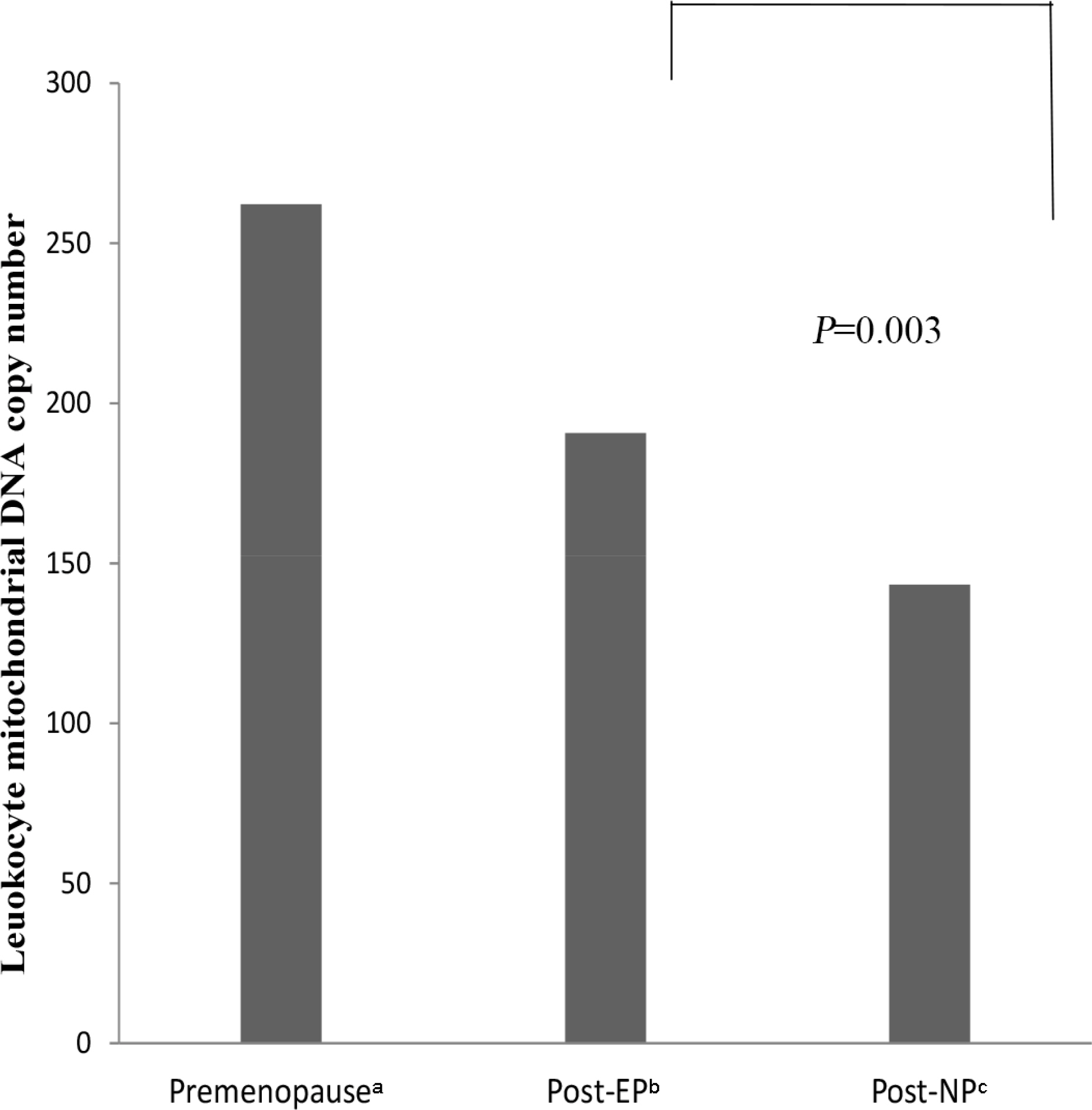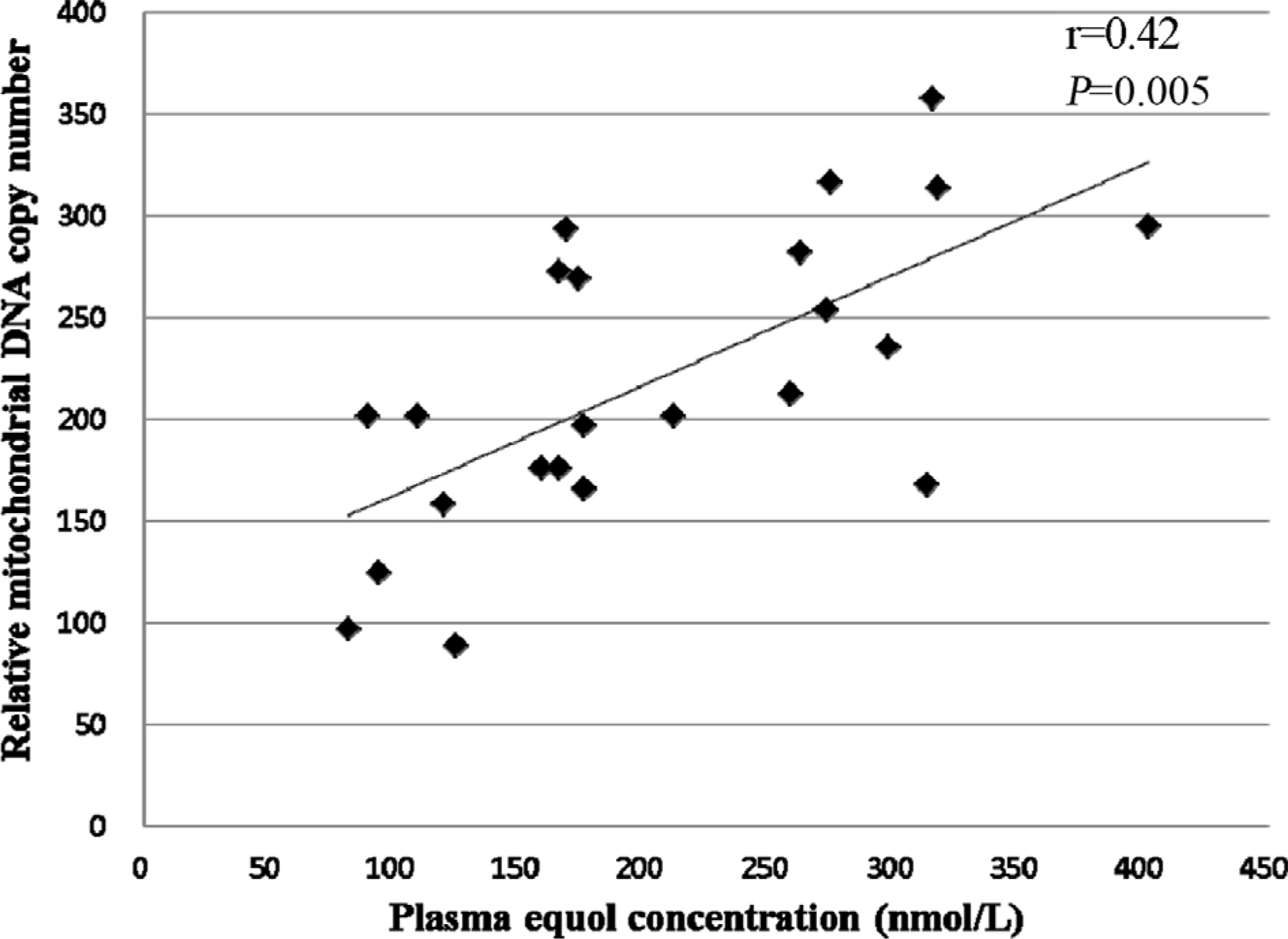Korean J Health Promot.
2015 Sep;15(3):108-114. 10.15384/kjhp.2015.15.3.108.
Equol Production and Increased Leukocyte Mitochondrial DNA in Postmenopausal Women
- Affiliations
-
- 1Department of Family Medicine, Chung-Ang University Hospital, Chung-Ang University College of Medicine, Seoul, Korea. girlpower219@cau.ac.kr
- 2Department of Microbiology, Chung-Ang University College of Medicine, Seoul, Korea.
- 3Department of Physiology, Chung-Ang University College of Medicine, Seoul, Korea.
- KMID: 2247204
- DOI: http://doi.org/10.15384/kjhp.2015.15.3.108
Abstract
- BACKGROUND
Equol, a metabolite of diadzein, is produced by some intestinal bacteria. Equol acts as an estrogen receptor agonist and has been reported to have several beneficial health effects. Leukocytes play an important role in the pathogenesis of autoimmune, metabolic, and cardiovascular diseases. Decreased leukocyte mitochondrial DNA (mtDNA) content, as an index of mitochondrial function, is associated with metabolic syndrome, bone mineral density, and aging. The possible association between equol production and leukocyte mitochondrial function has not been studied to date. Therefore, we investigated whether equol production is associated with leukocyte mtDNA copy number in postmenopausal women.
METHODS
This observational cross-sectional study included 71 postmenopausal women. They completed a lifestyle questionnaire and medical history. In addition, a dietary assessment using a 24-hour recall method and food frequency questionnaire, anthropometric evaluation, and blood sampling were conducted. Serum equol concentration was measured in the fasting state. Leukocyte mtDNA copy number was measured by real-time polymerase chain reaction.
RESULTS
Among older females, 33.8% were equol producers. The leukocyte mtDNA copy number was lower in non-equol producers versus equol producers. Furthermore, the leukocyte mtDNA copy number was positively associated with the serum equol concentration (r=0.42, P<0.01). Stepwise multiple regression analysis showed that equol production (beta=47.864, P<0.01) was an independent factor associated with mtDNA copy number.
CONCLUSIONS
Equol production was associated with elevated mtDNA content in the peripheral blood of postmenopausal women. This finding suggests that the beneficial health effects of equol in postmenopausal women may be related to increased mitochondrial function.
Keyword
MeSH Terms
Figure
Reference
-
1.Larkin T., Price WE., Astheimer L. The key importance of soy isoflavone bioavailability to understanding health benefits. Crit Rev Food Sci Nutr. 2008. 48(6):538–52.
Article2.Hong KW., Ko KP., Ahn Y., Kim CS., Park SJ., Park JK, et al. Epidemiological profiles between equol producers and non-producers: a genomewide association study of the equol-producing phenotype. Genes Nutr. 2012. 7(4):567–74.
Article3.Franke AA., Lai JF., Halm BM., Pagano I., Kono N., Mack WJ, et al. Equol production changes over time in postmenopausal women. J Nutr Biochem. 2012. 23(6):573–9.
Article4.Setchell KD., Cole SJ. Method of defining equol-producer status and its frequency among vegetarians. J Nutr. 2006. 136(8):2188–93.
Article5.Aso T., Uchiyama S., Matsumura Y., Taguchi M., Nozaki M., Takamatsu K, et al. A natural S-equol supplement alleviates hot flushes and other menopausal symptoms in equol nonproducing postmenopausal Japanese women. J Womens Health (Larchmt). 2012. 21(1):92–100.
Article6.Jackson RL., Greiwe JS., Schwen RJ. Emerging evidence of the health benefits of S-equol, an estrogen receptor β agonist. Nutr Rev. 2011. 69(8):432–48.
Article7.Long J., He P., Shen Y., Li R. New evidence of mitochondria dysfunction in the female Alzheimer's disease brain: deficiency of estrogen receptor-β. J Alzheimers Dis. 2012. 30(3):545–58.
Article8.Kim JH., Im JA., Lee DC. The relationship between leukocyte mitochondrial DNA contents and metabolic syndrome in postmenopausal women. Menopause. 2012. 19(5):582–7.
Article9.Huang CH., Su SL., Hsieh MC., Cheng WL., Chang CC., Wu HL, et al. Depleted leukocyte mitochondrial DNA copy number in metabolic syndrome. J Atheroscler Thromb. 2011. 18(10):867–73.
Article10.Kim JH., Lee DC. Mitochondrial DNA copy number in peripheral blood is associated with femoral neck bone mineral density in postmenopausal women. J Rheumatol. 2012. 39(7):1465–72.
Article11.Simpkins JW., Yi KD., Yang SH., Dykens JA. Mitochondrial mechanisms of estrogen neuroprotection. Biochim Biophys Acta. 2010. 1800(10):1113–20.
Article12.Borrás C., Gambini J., López-Grueso R., Pallardó FV., Viña J. Direct antioxidant and protective effect of estradiol on isolated mitochondria. Biochim Biophys Acta. 2010. 1802(1):205–11.
Article13.Levey AS., Coresh J., Greene T., Stevens LA., Zhang YL., Hendriksen S, et al. Using standardized serum creatinine values in the modification of diet in renal disease study equation for estimating glomerular filtration rate. Ann Intern Med. 2006. 145(4):247–54.
Article14.Lee MJ., Kim JH. Estimated dietary isoflavone intake among Korean adults. Nutr Res Pract. 2007. 1(3):206–11.
Article15.Brouwers E., L'homme R., Al-Maharik N., Lapcík O., Hampl R., Wähälä K; K, et al. Time-resolved fluoroimmunoassay for equol in plasma and urine. J Steroid Biochem Mol Biol. 2003. 84(5):577–88.
Article16.Wong A., Cortopassi G. Reproducible quantitative PCR of mitochondrial and nuclear DNA copy number using the LightCycler. Methods Mol Biol. 2002. 197:129–37.
Article17.Setchell KD. Soy isoflavones--benefits and risks from nature's selective estrogen receptor modulators (SERMs). J Am Coll Nutr. 2001. 20(5 Suppl):354S–62S. discussion 381S-3S.
Article18.Ko TF., Tsai HS., Lin SM., Liu CD., Learn SP., Chiou RY. GC-MS determined distribution of urinary equol producers as affected by age, gender, and repeated ingestions of soymilk. J Food Sci. 2010. 75(9):H306–10.
Article19.Lee JH., Heo JM., Park YS., Park HM. Survey on the consumption of the phytoestrogen isoflavone in postmenopausal Korean women. J Korean Soc Menopause. 2012. 18(3):163–73.
Article20.Lim S., Kim SK., Park KS., Kim SY., Cho BY., Yim MJ, et al. Effect of exercise on the mitochondrial DNA content of peripheral blood in healthy women. Eur J Appl Physiol. 2000. 82(5-6):407–12.
Article
- Full Text Links
- Actions
-
Cited
- CITED
-
- Close
- Share
- Similar articles
-
- What Equol Can Do for Human Health?
- Association between Leukocyte Mitochondrial DNA Copy Number and Regular Exercise in Postmenopausal Women
- In Vitro Antifungal Activity of Equol against Candida albicans
- The role of mitochondrial DNA mutation on neurodegenerative diseases
- Protective effect of the isoflavone equol against DNA damage induced by ultraviolet radiation to hairless mouse skin



